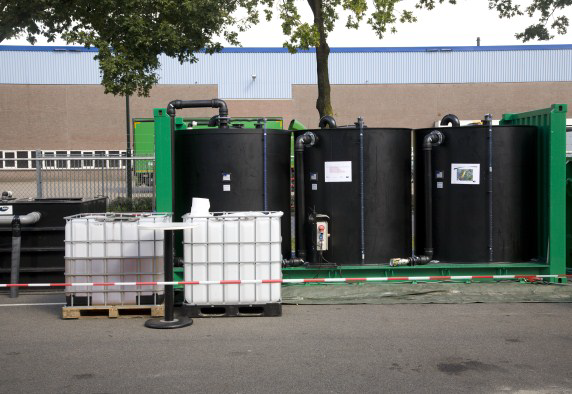Challenge
In the autumn of 2010, HMVT installed three bioscreens in a VOCl-contaminated site at Vanderlande Industries in Veghel, the Netherlands. The contamination extended to approximately 5 hectares in the groundwater at a depth of 5 to 20 metres. The natural degradation of the VOCl contamination has already reached an advanced stage. The bioscreens consist of more than 100 injection filters, installed at a depth of 6, 10, 15 and 20 metres in the plume zone of the VOCl contamination. The contamination in the source zone is slowly disappearing and no further action is undertaken in this respect for now.
Solution
A new injection unit, the so-called biostimulator, has been introduced for the biological decontamination process. HMVT developed the biostimulator for stimulating the break-down in case of large VOCl contaminations. Using this innovative injection unit, large quantities of soya bean oil are mixed with on-site groundwater. The biostimulator has 2 mixing tanks holding 8m3, as well as a special mixing pump. Using a fire hose, the prepared emulsion is pumped hundreds of metres away to a distributor unit on a trailer. From there, the emulsion is injected via 10 to 20 filters in one go. One injection cycle will be able to stimulate the biological degradation of VOCl for a period of approximately 5 years.
Results
The biostimulator has allowed HMVT to triple the production and injection speed. This improvement has made the stimulation of the breakdown process even more cost-effective. Within approximately 2 weeks, the biostimulator provided approximately 80 injection filters with 160m3 of substrate. The biostimulator will be able to cut biological remediation project costs by approximately 30%.
While HMVT is monitoring the process in Veghel, it appears the VOCl contamination in the bioscreens has already seen a substantial reduction in the first six months. We expect the VOCl concentration in the screen to be further reduced by 80 to 90% within a 5-year timeframe. CSO will monitor the situation of the contamination in the groundwater as part of the verification process. The ultimate goal of the remediation process is to stop the further spread of contaminated groundwater.

